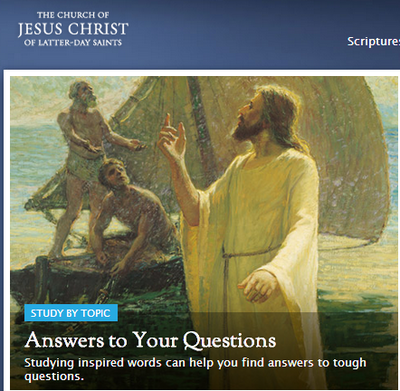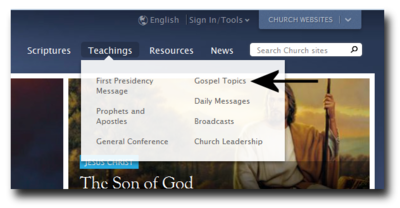FAIR Answers—back to home page
The Church's Gospel Topics essays on LDS.org
Summary: The Church has posted a series of Gospel Topics essays on LDS.org which discuss a variety of issues related to Church History and belief.
Jump to Subtopic:
Steven E. Snow: "The First Presidency and the Quorum of the Twelve both have been very supportive of this process"
The First Presidency and the Quorum of the Twelve both have been very supportive of this process....I think they sense the need to provide accurate information to our members to counter a lot of sensationalism that tends to come about online or on the Internet over some of these historical topics. We want them to be able to go to a place where they can read accurate information and be able to seek to understand those historical chapters in the context of time and place and understand these answers have been approved by the presiding Brethren of the church. I think that will give many of our members confidence that they can rely on those answers.[1]
Question: What has the Church done to help members learn about historical issues?
The Church has posted a series of essays on LDS.org in the Gospel Topics section
The Church has posted a series of essays on LDS.org in the Gospel Topics section. These essays have been written by historians and reviewed and approved by the First Presidency. In addition, material on these topics has been incorporated into new Seminary manuals. The Gospel Topics essays may be accessed through the main menu by selecting the "Teachings" menu on LDS.org, then selecting "Gospel Topics." The essays may be found under the alphabetical index. Additional essays will be posted on LDS.org in the upcoming months.
CHURCH ESSAYS


- First Vision Accounts—
Brief Excerpt: Joseph Smith published two accounts of the First Vision during his lifetime. The first of these, known today as Joseph Smith—History, was canonized in the Pearl of Great Price and thus became the best known account. The two unpublished accounts, recorded in Joseph Smith’s earliest autobiography and a later journal, were generally forgotten until historians working for The Church of Jesus Christ of Latter-day Saints rediscovered and published them in the 1960s. Since that time, these documents have been discussed repeatedly in Church magazines, in works printed by Church-owned and Church-affiliated presses, and by Latter-day Saint scholars in other venues.1 In addition to the firsthand accounts, there are also five descriptions of Joseph Smith’s vision recorded by his contemporaries. (Click here for full article)
∗ ∗ ∗
- Book of Mormon Translation—
Brief Excerpt: Some accounts indicate that Joseph studied the characters on the plates. Most of the accounts speak of Joseph’s use of the Urim and Thummim (either the interpreters or the seer stone), and many accounts refer to his use of a single stone. According to these accounts, Joseph placed either the interpreters or the seer stone in a hat, pressed his face into the hat to block out extraneous light, and read aloud the English words that appeared on the instrument. The process as described brings to mind a passage from the Book of Mormon that speaks of God preparing “a stone, which shall shine forth in darkness unto light.” (Click here for full article)
∗ ∗ ∗
- Race and the Priesthood—
Brief Excerpt: In 1852, President Brigham Young publicly announced that men of black African descent could no longer be ordained to the priesthood, though thereafter blacks continued to join the Church through baptism and receiving the gift of the Holy Ghost. Following the death of Brigham Young, subsequent Church presidents restricted blacks from receiving the temple endowment or being married in the temple. Over time, Church leaders and members advanced many theories to explain the priesthood and temple restrictions. None of these explanations is accepted today as the official doctrine of the Church.....Today, the Church disavows the theories advanced in the past that black skin is a sign of divine disfavor or curse, or that it reflects actions in a premortal life; that mixed-race marriages are a sin; or that blacks or people of any other race or ethnicity are inferior in any way to anyone else. Church leaders today unequivocally condemn all racism, past and present, in any form. (Click here for full article)
∗ ∗ ∗
- Are Mormons Christian?—
Brief Excerpt: While members of The Church of Jesus Christ of Latter-day Saints have no desire to compromise the distinctiveness of the restored Church of Jesus Christ, they wish to work together with other Christians—and people of all faiths—to recognize and remedy many of the moral and family issues faced by society. The Christian conversation is richer for what the Latter-day Saints bring to the table. There is no good reason for Christian faiths to ostracize each other when there has never been more urgent need for unity in proclaiming the divinity and teachings of Jesus Christ. (Click here for full article)
∗ ∗ ∗
- Book of Mormon and DNA studies—
Brief Excerpt: Nothing is known about the extent of intermarriage and genetic mixing between Book of Mormon peoples or their descendants and other inhabitants of the Americas, though some mixing appears evident, even during the period covered by the book’s text. What seems clear is that the DNA of Book of Mormon peoples likely represented only a fraction of all DNA in ancient America. Finding and clearly identifying their DNA today may be asking more of the science of population genetics than it is capable of providing. (Click here for full article)
∗ ∗ ∗
- Becoming like God—
Brief Excerpt: Since human conceptions of reality are necessarily limited in mortality, religions struggle to adequately articulate their visions of eternal glory. As the Apostle Paul wrote, “Eye hath not seen, nor ear heard, neither have entered into the heart of man, the things which God hath prepared for them that love him.” These limitations make it easy for images of salvation to become cartoonish when represented in popular culture. For example, scriptural expressions of the deep peace and overwhelming joy of salvation are often reproduced in the well-known image of humans sitting on their own clouds and playing harps after death. Latter-day Saints’ doctrine of exaltation is often similarly reduced in media to a cartoonish image of people receiving their own planets. (Click here for full article)
∗ ∗ ∗
- Peace and Violence among 19th-Century Latter-day Saints—
Brief Excerpt: [E]arly Latter-day Saints did not obtain peace easily. They were persecuted, often violently, for their beliefs. And, tragically, at some points in the 19th century, most notably in the Mountain Meadows Massacre, some Church members participated in deplorable violence against people they perceived to be their enemies. This essay explores both violence committed against the Latter-day Saints and violence committed by them. While historical context can help shed light on these acts of violence, it does not excuse them. (Click here for full article)
∗ ∗ ∗
- Translation and Historicity of the Book of Abraham—
Brief Excerpt: We do know some things about the translation process. The word translation typically assumes an expert knowledge of multiple languages. Joseph Smith claimed no expertise in any language. He readily acknowledged that he was one of the “weak things of the world,” called to speak words sent “from heaven.”1 Speaking of the translation of the Book of Mormon, the Lord said, “You cannot write that which is sacred save it be given you from me.”2 The same principle can be applied to the book of Abraham. The Lord did not require Joseph Smith to have knowledge of Egyptian. By the gift and power of God, Joseph received knowledge about the life and teachings of Abraham. (Click here for full article)
∗ ∗ ∗
- Plural Marriage in The Church of Jesus Christ of Latter-day Saints—
Brief Excerpt: Latter-day Saints believe that the marriage of one man and one woman is the Lord’s standing law of marriage. In biblical times, the Lord commanded some to practice plural marriage—the marriage of one man and more than one woman.1 By revelation, the Lord commanded Joseph Smith to institute the practice of plural marriage among Church members in the early 1840s. For more than half a century, plural marriage was practiced by some Latter-day Saints under the direction of the Church President.2 (Click here for full article)
∗ ∗ ∗
- Plural Marriage in Kirtland and Nauvoo—
Brief Excerpt: After receiving a revelation commanding him to practice plural marriage, Joseph Smith married multiple wives and introduced the practice to close associates. This principle was among the most challenging aspects of the Restoration—for Joseph personally and for other Church members. Plural marriage tested faith and provoked controversy and opposition. Few Latter-day Saints initially welcomed the restoration of a biblical practice entirely foreign to their sensibilities. But many later testified of powerful spiritual experiences that helped them overcome their hesitation and gave them courage to accept this practice. (Click here for full article)
∗ ∗ ∗
- Plural Marriage and Families in Early Utah—
Brief Excerpt: After the Manifesto, monogamy was advocated in the Church both over the pulpit and through the press. On an exceptional basis, some new plural marriages were performed between 1890 and 1904, especially in Mexico and Canada, outside the jurisdiction of U.S. law; a small number of plural marriages were performed within the United States during those years.4 In 1904, the Church strictly prohibited new plural marriages. Today, any person who practices plural marriage cannot become or remain a member of the Church. (Click here for full article)
∗ ∗ ∗
- The Manifesto and the End of Plural Marriage—
Brief Excerpt: The end of plural marriage required great faith and sometimes complicated, painful—and intensely personal—decisions on the part of individual members and Church leaders. Like the beginning of plural marriage in the Church, the end of the practice was a process rather than a single event. Revelation came “line upon line, precept upon precept. (Click here for full article)
∗ ∗ ∗
Notes
- ↑ Elder Steven E. Snow, Church Historian, quoted in "LDS Church enhances web pages on its history, doctrine," Deseret News (9 December 2013) off-site

